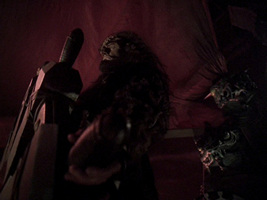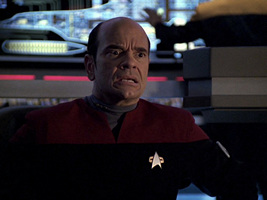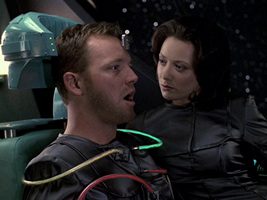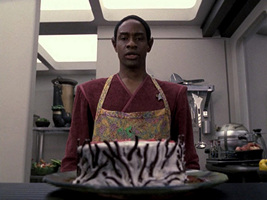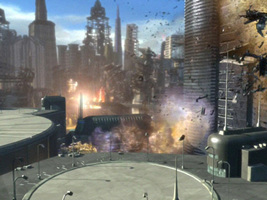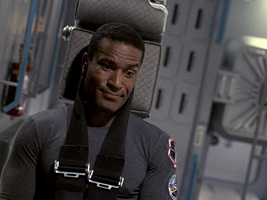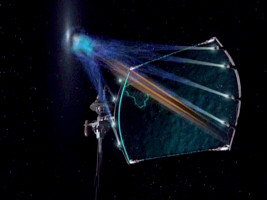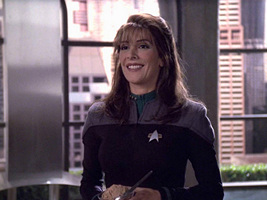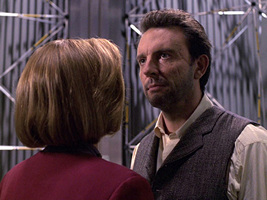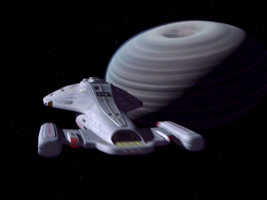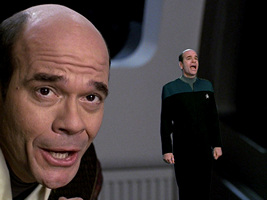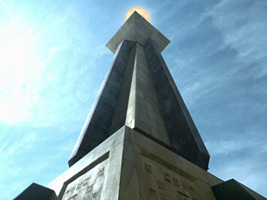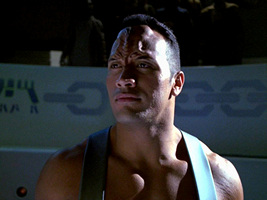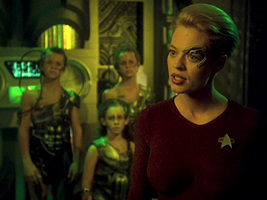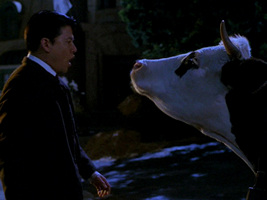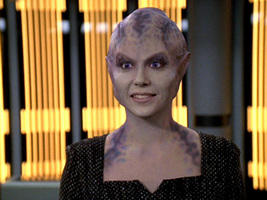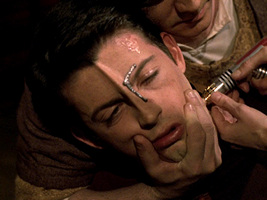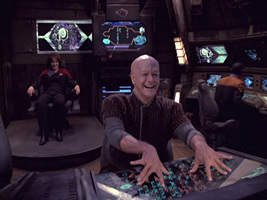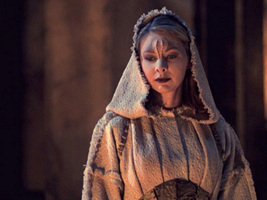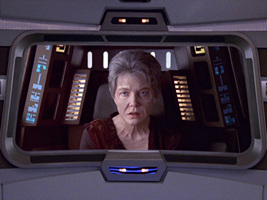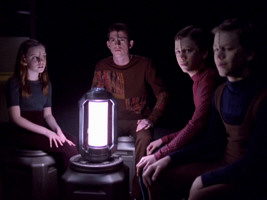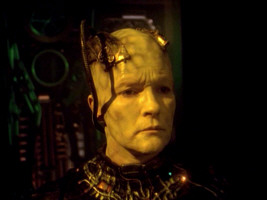Star Trek Voyager (VOY) Season 6
Season 1Season 2Season 3Season 4Season 5Season 6Season 7
Survival InstinctBarge of the DeadTinker, Tenor, Doctor, SpyAliceRiddlesDragon's TeethOne Small StepThe Voyager ConspiracyPathfinderFair HavenBlink of an EyeVirtuosoMemorialTsunkatseCollectiveSpirit FolkAshes to AshesChild's PlayGood ShepherdLive Fast and ProsperMuseFuryLife LineThe Haunting of Deck TwelveUnimatrix Zero I/II
Equinox II
See VOY season 5
Survival Instinct
Synopsis
Stardate 53049.2: As Voyager is docked to a Markonian space station, a massive multicultural hub, numerous visitors come aboard the ship. Among them is a man named Lansor, who gives Seven of Nine Borg implants that once belonged to her. He doesn't reveal the whole story and his plan, however. He and two other visitors, Wilkara and P'Chan, are former Borg drones. They were part of Unimatrix 01, just like Seven of Nine, and are telepathically linked after they escaped from the Collective, for reasons they don't know. As Seven is in her regeneration cycle, they break into the cargo bay and establish a link with her in the hope of severing their own links. But security apprehends them. Eight years ago, a Borg sphere crashed on Planet 1865-Alpha, with these three drones and Seven being the only survivors. They were eventually reassimilated. But all of them, including Seven, have a memory gap about what happened on that planet. Seven agrees to link with them again to find out the truth. It turns out that the other three drones rediscovered their individuality after the crash. Seven, who was assimilated as a child, was afraid of being alone after running into a dead drone. She injected nanoprobes into the other survivors that would tie their minds together and suppress their feelings of being individuals. This link still persists. Lansor, Wilkara and P'Chan go into a neural shock. In order to save them, they would have to be returned to the Collective. But Seven eventually recognizes that they deserve to live on as individuals and their link should be broken up, although they only have a month left. Wilkara, who was a Bajoran Starfleet officer, stays aboard the ship, Lansor decides to enjoy life on the station and P'Chan chooses to spend his final days on a lonely planet.
Commentary
"Survival Instinct" shows the struggle between individuality and the collective mind more impressively than any other Borg-themed story so far. Especially the camp fire scene is very touching, as the four drones begin to remember their former lives. This is even more remarkable considering that it could easily have turned into silliness when fully armored Borg suddenly don't behave like drones any more and start talking about their childhood or family. Writer, director and actors did a great job to prevent that from happening. When I first watched "Survival Instinct", it temporarily reconciled me with the role of the Borg on Voyager. Some of the previous episodes were inconsequential and squandered their potential, by first presenting them as formidable enemies but then eluding them too easily. "Survival Instinct" demonstrates that it doesn't even need a direct Borg threat to make a good Borg episode.
Overall, this would have been a simple and straightforward story, but it is written to appear more complex using two storytelling devices. The first is that we are left in the dark about the plan of the three telepathically linked visitors. This remains a bit too indefinite and comes with a few problems, as mentioned in the annotations. The flashbacks to the drones stranded on the planet work much better, as each of them reveals just the right amount of new facts to keep up the suspense.
One important outcome is that individuality rules over uniformity and the latter can only be reconstituted by force. The other one is that it wasn't the drone Seven of Nine, but rather the little girl Annika that reassimilated the other drones, because she was afraid of being alone. She was not really less of an individual at the time, but she behaved like the little child she was at the time of her assimilation.
Annotations
- Continuity: In "One", Seven noted that she had once been severed from the Collective for two hours. This could well refer to what happened in "Survival Instinct".
- Nitpicking:
- Wouldn't a Bajoran visitor raise a lot of suspicion in the Delta Quadrant? Wouldn't people with large scars just where the Borg customarily place their implants raise suspicion?
- What is the reason for Lansor to give Seven the Borg implants? Doesn't that raise unwanted suspicion as well?
- Remarkable quotes:
- "Oh, it's got me by the hair" (Janeway about the plant she has received as a gift)
- "Stand aside!" (Seven, as she and Naomi want to pass the crowded corridor)
- Remarkable dialogues:
- "This morning's security report." - "A broken ODN line, some missing personal items, a damaged scanner relay. All in all, not that bad." - "There is a second page to the report." - "Oh. Some of these incidents are a little more serious but, on balance, I still think we did the right thing." - "There is a third page." (Tuvok and Janeway)
- "In the Collective there are billions of voices. They become white noise." - "But with only three..." - "...each voice comes through clearly." (Seven and two of the drones, technically correct)
- "Naomi Wildman. Do you consider me to be family?" - "I, I don't, I mean. Yes. Is that okay?" - "I have no objection." - "Do you think of me as family?" - "Yes." (Seven and Naomi)
- "I will not return them to the Borg." - "Are you thinking of what's best for them, or for you?" - "Clarify." - "You said it yourself. You made a mistake. And Seven of Nine doesn't like to make mistakes. She strives for perfection. I want you to think about the motivation behind your decision. Are you doing what's right for those three people, or are you trying to alleviate the guilt you feel over what happened eight years ago?" (Seven and the Doctor)
- The drones:
- Lansor aka 2 of 9, primary adjunct, male member of unknown species
- Marika aka 3 of 9, auxiliary processor, Bajoran female, officer aboard the Excalibur
- P'Chan aka 4 of 9, secondary adjunct, male member of Species 571
- Remarkable species: Species 521, Shivolian
- Remarkable aliens: There are a number of aliens with previously seen make-ups. We see several Voth ("Distant Origin"), which makes sense since the have transwarp drive. There is also someone who looked like Prof. Torat ("Counterpoint") and a member of the "monster hunter's" race ("Bliss"). One alien that doesn't make sense at all was the little guy who is seen in the corridor twice and who looks exactly like the alleged Talarian from DS9: "Improbable Cause" (see Races with Changing Faces - Talarians).
Rating: 6
Barge of the Dead
Synopsis
Stardate not given: After getting into an ion storm, B'Elanna is glad that she can crash land her shuttle in the shuttlebay and get away with a few contusions. Chakotay comes to her quarters with a Klingon artifact that somehow got stuck in her port nacelle. Suddenly everyone on the ship is into Klingon rituals, such as Tuvok, who insists to give her a bat'leth lesson. It culminates in a festivity in B'Elanna's honor, with bloodwine, drinking songs and replicated gagh that looks like it is alive. Suddenly Klingons appear and kill everyone. B'Elanna finds herself on the Barge of the Dead, which she so far thought of as only a myth. The ship is going to take her to Gre'thor, the place for dishonored Klingon souls. While on the barge, she briefly sees that someone new arrives - her mother Miral. B'Elanna wakes up in sickbay. She became unconscious in the ion storm and her shuttle was actually tractored in. Nothing she experienced was real. But B'Elanna begins to worry about her mother, who was always fond of everything Klingon and who may be on her way to Gre'thor because her daughter dishonored her. She persuades Janeway to allow her return to the Barge of the Dead, by reproducing the conditions that let her become unconscious. Back on the Barge of the Dead, B'Elanna agrees to go to Gre'thor in her mother's place and have her sent to Sto-vo-kor. She herself arrives at Gre'thor, where she meets the crew of Voyager, now celebrating her dishonor. But Miral appears too. She tells her daughter to go her own way and that they will meet again, either in Sto-vo-kor or in real life.
Commentary
There were two episodes with focus on B'Elanna in season 5, "Extreme Risk" and "Juggernaut", both of which should have been better aligned with one another and with the greater context of the series. "Barge of the Dead" plays safe in this regard, as it is a story that can be told any time, without the need to establish more than general character traits. Interestingly, Voyager already had a similar story with opposite preconditions with "Mortal Coil", where Neelix was devastated that he hadn't experienced the afterlife he had believed in. Maybe it would have been a nice nod to refer to this episode and to involve Neelix in some capacity.
Anyway, we can take for granted that B'Elanna, unlike Neelix, doesn't believe in an afterlife. At least, we can easily imagine it, considering that she was never fond of the Klingon part of her heritage. In this regard, it is a good idea to show how everyone on the ship suddenly engages in all things Klingon after the very unlikely discovery of the artifact. But all this is still within the possibilities of the show. Only slowly the story gives away that what is happening isn't real. And although it reminds me a tad too much of how the truth unfolded in "Coda", it keeps the episode entertaining for the first 15 minutes.
When I first watched it, I didn't like what happens on the Barge of the Dead and I thought of it as pointless. But seeing it again after many years, it now makes more sense. At least, it would make sense to someone who either clings to Klingon myths or who has internalized them in their childhood, as it is the case with B'Elanna. So although she doesn't believe in it, the correspondence of what she experiences with what she once learned becomes convincing. Of course, this is circular reasoning once we make the simple assumption that everything happens only in her mind. The decisive cue that the afterlife experience isn't real comes from her mother in the end, when she says they may meet again when B'Elanna comes home.
On the other hand, it still bothers me that the Klingon afterlife is as realistic as a holodeck program. How could B'Elanna imagine such a detailed version of Kortar and his barge from a few childhood memories? So convincing that she would take a leap of faith and risk her own life for the presumed salvation of her mother? Interestingly, in Star Trek alien myths are always vivid, powerful and, in some way, superior to Earth's technocracy. It is also noteworthy that not even Chakotay, the only human in so far 30 years of Star Trek who is shown as a spiritual person, seems to be sure that there is an afterlife.
"Barge of the Dead" is a significant episode in hindsight. B'Elanna will embrace her Klingon heritage again, and she will name her daughter Miral after her mother.
Annotations
- Remarkable quote: "I accept there are things in the universe than can't be scanned with a tricorder." (Chakotay)
- Remarkable Klingon: The legend of Kortar, the first Klingon, who destroyed the gods and was condemned to steer the Barge of the Dead for all eternity is a nifty piece of Klingon mythology. He seems to be the Klingon version of both Prometheus and Charon. Kortar's forehead looks "ancient" like that of Kahless.
- Remarkable facts: B'Elanna almost drowned in the Sea of Gatan when she was a child. Her mother calls her "Lanna". The two haven't talked in ten years.
Rating: 5
Tinker, Tenor, Doctor, Spy
Synopsis
Stardate not given: A nifty addition to the Doctor's program allows him to play the ship's resident superhero in some kind of daydreams. He heals Vulcan pon farr, is being desired by all women and, in the role of the "Emergency Command Hologram" (ECH), blows a Borg sphere to dust with his "photonic cannon". He also files a request to Janeway to further develop his program in a way to make these dreams come true, which the captain declines. Incidentally, an observer on a ship of the Hierarchy has discovered Voyager as a possible target of a raid. He can't scan the ship's interior, but he intercepts the Doctor's daydreams and takes them for real. He doesn't know yet why the link drops out intermittently (which is whenever the Doctor interacts with the real world). Against the orders of his immediate superior, he receives permission from the Hierarachy to continue the observations. At some point, the Doctor's daydreams run out of control because of this interference. B'Elanna spends a whole night to fix the program and remove the responsible subroutines. In the meantime, the observer has received the Hierarchy's approval to begin a Type-3 stealth attack on Voyager. But the Doctor's erratic behavior prior to the program fix and the end of the transmissions tell him he made a mistake. He secretly contacts the Doctor by inducing another daydream and warns him of the imminent raid. No one on the bridge believes the Doctor that this time there is a real danger until Kim modifies the sensors and discovers the cloaked Hierarchy vessels. The Doctor poses as Voyager's ECH so the Hierarchy guy would not be demoted for providing false information. But the Hierarchy has changed plans and switched to a Type-4 attack, which means rotating phaser frequencies and no chance for Voyager. The Doctor improvises and orders Tuvok to activate the fictitious photonic cannon (that the Hierarchy assumes destroyed a Borg sphere). The Hierarchy falls for the ruse and retreats. Janeway reconsiders her rejection to extend the EMH's program and launches an according research project.
Commentary
This is still one of the funniest Star Trek episodes ever made. I don't remember the exact circumstances, but it was past midnight when we first watched it, and we probably roused the whole house during the opening scene with the aria (which we probably played several times). There are so many jokes that cross the line to silliness, but I think this is forgivable because we can easily imagine the Doctor would actually have dreams like these (as would many of us). I admit that some of his fantasies are sexist and probably wouldn't be shown like that in a modern-day series. But I don't mind. I want to enjoy the series, and not feel compelled to watch it as a moral nitpicker.
The crew's exploration of the Doctor's dream world is reminiscent of what happened in TNG: "Hollow Pursuits", when Riker and fellow officers stumbled upon Barclay's odd holographic fantasies. I also think that the Doctor's embarrassment about someone seeing his private activities in detail sort of compensates for the sexism in his imagination. At least, it doesn't remain uncommented.
Although the Hierarchy poses an actual danger, humor prevails in "Tinker, Tenor, Doctor, Spy" after the daydreams have stopped. It is adorable how the Doctor is suddenly uncertain in a real-life situation. The made-up "photonic cannon" is a wonderful homage to TOS: "The Corbomite Maneuver". And I love how the guy on the Hierarchy ship, who apparently has a boring life, becomes a fan of the Doctor and his exciting life.
"Tinker, Tenor, Doctor, Spy" is a fun story in the first place. There are some serious aspects in it that might have been examined more consequentially. But I am not sure whether it would have been the right time for a debate whether it is adequate to have sexual fantasies about fellow crew members and whether it is admissible for the captain to disclose those fantasies to pretty much everyone. Overall, I'm very satisfied with the way the story is.
Annotations
- Remarkable fun scenes:
- Janeway's, B'Elanna's and Seven's struggle for the Doctor during a briefing
- The Doctor's painting session with Seven as his nude model - while the real Seven is watching
- The Doctor telling B'Elanna that she should return to poor Tom instead of longing for the Doctor's love
- Remarkable aria (original from Rigoletto by Giuseppe Verdi):
| La donna è mobile qual piuma al vento, muta d'accento e di pensier. Sempre un' amabile La donna è mobile |
Tuvok, I understand You are a Vulcan man. You have just gone without For seven years about. Paris, please find a way Hormones are raging, |
- Remarkable computer messages:
- "Warning. Warp core breach a lot sooner than you think."
- "Warning. Last chance to be a hero, Doctor. Get going!"
- Remarkable VFX: the Doctor's uniform changing from blue to the red ECH version and four pips appearing on his collar
Rating: 8
Alice
Synopsis
Stardate not given: Voyager runs into a scrapyard in open space and purchases a number of items from its owner Abaddon. Among them is a small shuttle, which Tom begins to restore in his spare time and which he names Alice. The shuttle is equipped with a neurogenic interface. Once Tom hooks himself up to the shuttle's computer, Alice recognizes that he is a compatible pilot and begins to influence his mind. In the following, Tom neglects his duties and his relationship with B'Elanna. At one point, when B'Elanna is investigating Alice's systems more closely, she gets trapped inside and the air gets sucked out. Tom arrives in the nick of time and saves her, but doesn't believe the shuttle wanted to kill her. B'Elanna reports the incident to the captain. Tom is willing to report to sickbay, but on the way there, a human manifestation of Alice persuades him to proceed to the shuttlebay. He escapes with Alice, and there is no trace as to what their destination could have been. Janeway contacts Abaddon. He holds back something and is willing to talk only when Neelix offers to return a valuable beryllium crystal that Abaddon gave away by accident. It turns out that he himself was also under the influence of Alice. Seven can reconstruct Tom's flight path based on something she saw him plot in astrometrics. Alice is heading for a particle fountain that she considers "home" and that would destroy the shuttle and kill Tom. As firing the weapons could harm Tom, the crew devises a plan for B'Elanna to tap into the neural interface to create a diversion, while Tuvok shuts down the shuttle's computer. Tom can be beamed out in time, whereas Alice gets destroyed.
Commentary
I nicknamed this episode "Stephen King's Christine in Space" when I first reviewed it many years ago. "Alice" relies too much on conventional horror themes and is overall too predictable. It becomes apparent from the start that there is something wrong with the small shuttle. It is too obvious that Tom would get himself into trouble. It is also implausible. We are seriously meant to believe that Tom would hook himself up to a neural interface without any precautions and without anyone having objections? And this is just the first example of carelessness on the predetermined way into disaster. Tom is like junkie or a brainwashed cult follower in "Alice" but he is never out of his mind. He could end his relationship with Alice before it is too late. Likewise, everyone else is aware of how deranged Tom is. It speaks in Chakotay's favor that he is lenient when Tom neglects his duties. It is nice of B'Elanna to try to become friends with her "rival" Alice. But the two could and should have reacted sooner.
I also would have liked to learn more about the origin of the shuttle and why there is something wrong it it, and why a "compatible" pilot is needed when all Alice wants is to commit suicide. This all remains shrouded in mystery and makes the less sense the more I think about it.
There are three positive aspects though: Firstly, Tom's character is consistent with previous episodes like "Vis-à-Vis" or "Thirty Days", in which he developed a similar obsession when he could make his dream come true. It may be a bit too stereotypical by now to portray Tom as on officer who forgets his duty when the right car or ship comes along. Yet, I appreciate if the writers stick with what they have once established, instead of adding new characteristics out of the blue to a person. Secondly, my apprehension that B'Elanna wouldn't play a role in a story built around Tom proves false. On a couple of previous occasions the writers seemed to have forgotten that they are a couple since "Day of Honor". Thirdly, the acting is excellent, especially the interaction in the love triangle of Robert Duncan McNeill as Tom, Roxanne Dawson as B'Elanna and Claire Rankin as Alice (although I remembered the latter as being more seductive than it is my impression now).
Annotations
- Nitpicking: There is still one more question that bugs me. How can Tom's vital functions be monitored and how can B'Elanna's image be projected through Alice's multiphasic shields?
- Remarkable joke(?): "We have already a full complement of shuttles." (Chakotay) - Stop, rewind, play, point and laugh. Yes, he really says that, the ship's chief shuttle scrapper, sincere like the boy lying about the whereabouts of mum's chocolate while still munching the last bit of it.
- Remarkable fact: Tom's father had an S-Class shuttle - no warp drive and manual helm control.
- Shuttles lost: 1 (albeit none of Chakotay's "full complement")
Rating: 3
Riddles
Synopsis
Stardate 53263.2: As he and Neelix are on the Delta Flyer, returning from diplomatic talks with the Naroq, Tuvok seeks quiet in the aft section. He suddenly spots a cloaking field. But just as he scans the phenomenon, he gets attacked by an unknown enemy. Tuvok has suffered severe brain damage, and the Doctor can do nothing beyond saving his life. Investigator Kesat of the Naroq suspects that the attacker was the Ba'neth, who are more like a myth among his people but whose existence he is eager to prove. He finds residue of the cloaking and can create a coarse image of the perpetrator. But only the exact cloaking frequency could help find the Ba'neth and a cure for Tuvok. As he wakes up from the coma, Tuvok has lost most of his abilities and his logic. But he begins to enjoy a life full of fun and other emotions, with Neelix as a role model. Janeway successfully exposes nearby Ba'neth ships for a brief moment, but they go into hiding again. Tuvok eventually remembers the frequency or, more exactly, draws what he saw on the display when he scanned the cloaking field. With the new knowledge, Voyager detects a Ba'neth outpost, and Janeway threatens to disclose its location to the Naroq. She offers them tactical data in exchange for the specs of the weapon used to attack Tuvok. But the Ba'neth keep firing, with the reasoning that Kesat is a threat to them. Kesat steps in and offers the Ba'neth to reveal the technology of his detector, so they can adapt their cloaking. The Doctor eventually finds a method to restore Tuvok's brain. Tuvok is initially unwilling to undergo the procedure because he loves his new life. But Neelix can convince him that he should become the old Tuvok again, even though this means that the Vulcan would merely tolerate him.
Commentary
When I was going to watch this episode for the first time, my expectation was that it would be a bit like "Tuvix". There are a couple of analogies in the plot. Most obviously it is about an emotional Tuvok, only this time still as an individual person and not fused with Neelix. This new Tuvok is reluctant to be restored to the person he was, much like Tuvix - fortunately without armed guards taking him to sickbay. But this is where the similarities end.
We may say that "Riddles" plays overly nice and evades the possible controversy about Tuvok not wanting to return to his old life. We may take offense that the "old" logical Tuvok is said to be a more valuable person than the "new" naive one, first in insinuations and then explicitly by Tuvok himself. Neelix even states that the crew needs their highly skilled chief of security as the main reason why Tuvok should undergo the reconstructive brain surgery, rather than taking into consideration what may be the best for his friend. Actually, the reasoning "When is a Vulcan no longer a Vulcan?" that Neelix applied when discussing with Seven earlier in the episode would have been more appropriate in the situation.
However, in my impression the story is not meant to be an ethical debate in the first place. Rather than that, it is about a person who has to cope with the intellectual limits after his brain has been wiped clean. It is a bit like what happened to Uhura in "The Changeling", only that we hardly saw anything of her condition in the TOS episode and an unfortunate reset button was pressed that returned her to normal in the following episode. "Riddles" makes up for this mistake and can be compared with other classics like "The Deadly Years" or "The Loss" in this regard. Yet, the story mitigates the aspect of the loss just as well. Tuvok may have been demented after his neural shock. Well, we've already had something like that in "Spock's Brain"... Anyway, Tuvok actually becomes a child-like person, who initially is not bothered by being limited but curiously discovers the world around him.
I appreciate the decision not to exploit the opportunity of showing a "dumb Vulcan" to the fullest. It is endearing how Tuvok (and Tim Russ playing him) deals with his disability and explores his own personality again. And even though he later recognizes what he has lost ("I… *was*… an extraordinary fellow."), he does not allow it to drag him down. In my old review, I considered the possibility that tending to things the old Tuvok would have disliked is a sort of coping mechanism. But I now believe that sweet desserts and easy listening are genuine interests of the new Tuvok, who starts with a clean slate and whose brain is being rewired (with Neelix unintentionally having a hand in it).
With Tuvok's experiences being in the focus, scientific or medical questions play a minor role in the plot. Perhaps this is more like a blessing than a curse because the procedure to rebuild a Vulcan brain exactly the way it was is so implausible that it would defy explanation. This too is something we've already had in "Spock's Brain".
When I first watched it, I didn't care too much for the B-plot - until the moment when the alien "Fox Mulder" Naroq, who was previously obsessed to find the Ba'neth, lets go of the Ba'neth to save Tuvok. This unexpected selfless act is what I love about Trek. Another memorable moment comes at the end of the episode. I was expecting that some aspect of the "funny" Tuvok would persist - and I was not disappointed when he picked up Neelix's silly play on words from the beginning.
Overall, "Riddles" may not be quite as consequential and definitely not as controversial as "Tuvix", but it is a well-rounded episode in its own right.
Annotations
- Nitpicking: Tuvok sketches up a waveform without a scale on his cake. It is impossible to extract a frequency from this drawing.
- Remarkable quote: "If anyone can provoke Tuvok, Mr. Neelix, it's you." (Doctor)
- Remarkable music: Vulcan music which the Doctor calls "dreadful noise" (it's not "La donna è mobile" after all). I'm inclined to agree.
- Remarkable ship: The Ba'neth ship is a reuse of the Akritirian patrol ship.
Rating: 8
Dragon's Teeth
Synopsis
Stardate 53167.9: Voyager gets drawn into a subspace corridor. Ships of the Turei arrive, who demand to come aboard and wipe all data on the channels, which they claim for themselves. As Janeway refuses, the Turei begin to attack. Voyager finds shelter on the surface of a nearby planet, which buys the ship time because the Turei can't follow into the radiation-poisoned atmosphere. The planet turns out to have been the home to a civilization that was destroyed by orbital bombardment centuries ago. As Harry detects lifesigns underneath the surface, Janeway beams down a team. Seven wakes up one of the survivors to find answers. The man named Gedrin is a Vaadwaur. He and 600 more of his battalion went into stasis as long as 892 years ago when their planet was being devastated by their enemies, including the Turei. They were planning to wake up five years later, in the hope of finding a new home after the dust had settled. But the control system was compromised. Gedrin helps Voyager by activating a satellite that allows to get a target lock on the Turei ships in orbit. Janeway authorizes to wake up more Vaudwaar, including their leader Gaul, and offers them help to leave the planet by drawing the attention of the Turei to Voyager. But Gaul secretly plans to seize her ship. Neelix becomes suspicious about the Vaadwaur. He knows that his people were once in contact with them. He asks Seven to check Borg sources on the species. They conclude that the Vaadwaur used the subspace corridors to invade other worlds, rather than for research. Janeway maintains the deal but decides that all Vaadwaur ships have to remain unarmed during the escape attempt. However, Gaul has already jumped into action. He launches a large number of small ships that begin to attack Voyager. Janeway contacts the Turei and offers them the satellite link so they can destroy the Vaadwaur. She unexpectedly receives help from Gedrin. He has changed his mind and agrees to activate the uplink, which has to be done from the hiding place underneath the surface. As the chamber collapses, he remains behind and dies. Voyager has taken heavy damage, but thanks to harvested radiation particles the engines can be boosted and the ship clears the thermosphere. The Turei destroy most of the Vaadwaur vessels, but approximately 53 make it past the enemy and enter the subspace corridors.
Commentary
Ever since Khan was defrosted in TOS: "Space Seed", we know that a stasis pod is Star Trek's equivalent of Pandora's box. And so our selfless crew makes a deal with the unfortunate Vaadwaur, only to realize that these folks want revenge, rather than just find a new home.
The Vaadwaur are a Delta Quadrant species with a lot of potential, like only the Borg, the Voth and the Krenim before. This is why I would have loved to see them again. I would have liked to learn what has become of the 53 ships that managed to escape from the planet. It would have been interesting to delve further into their history, although Neelix's research was already nicely done. Most of all, I wonder how cruel a species could have been that they their enemies not only defeated them, but completely wiped out their civilization. The Vaadwaur actually became the victims at some time. In any case their desire for revenge is plausible, since their memory of the war is still fresh.
Yet, the story is a bit lacking in this regard in hindsight because we never really learn what the Turei think about their former enemies. Well, it has been 900 years, and they may not be overly emotional about the war any more. Then again, it has been 900 years and they suddenly face an enemy from ancient times all over again. So this is a bit of a squandered opportunity. Regarding the Vaadwaur, there should have been some more character development. The two main Vaadwaur characters, Gedrin and Gaul, would have deserved more lines or should have had more interaction with Voyager's crew, to make their opposite motivations clear. As it is customary in Trek, Gedrin's change of mind is supposed to be a surprise. Still, it could have been better prepared in the story.
I like the idea that Naomi is the first to notice that there is something wrong with the guests when the Vaadwaur children make racist remarks. But this should have been shown and not just told. We actually never see any Vaadwaur children in the episode.
The plot feels increasingly hasty and becomes a bit chaotic towards the end, as Gaul's ships begin to attack Voyager. I think it would have worked more smoothly with a few less plot complications or with more time. Overall, the story may have been better as a two-part episode.
In any case, the visual effects are fantastic, definitely among the best the series has shown so far. They would have sufficed for a two-parter.
Annotations
- Remarkable dialogue: "We don't know anything about this species. They could be hostile." - "Most humanoid cultures are." (Tuvok and Seven)
- Remarkable VFX: The scenes of the Vaadwaur city being destroyed, and Voyager amidst the ruins. Many of the buildings must have been more than 1km tall.
- Remarkable facts: 900 years ago, the Vaadwaur visited Talax and they also know the Borg. The Talaxians (then known as "Talax-ilzay") adopted the word "Vaadwaur", which means "foolish" or "reckless". The Borg had assimilated no more than a handful of systems at that time and the Collective has only rudimentary knowledge of the Vaadwaur. The Devore (from VOY: "Counterpoint") now have occupied one of the former Vaadwaur outposts.
- Ship landing: #5
Rating: 7
One Small Step
Synopsis
Stardate 53292.7: Voyager encounters a rare anomaly that is known as a graviton ellipse. It is traveling through subspace and occasionally emerges. When probes reveal characteristic material compositions of early spacecraft inside, Chakotay and Tom are excited that this is the very same phenomenon that swallowed the Mars spaceship Ares IV with astronaut John Kelly in 2032. Seven suggests to modify the Delta Flyer with Borg shielding to enter the graviton ellipse and salvage the old spaceship. But she only reluctantly joins the mission because she deems it a waste of time and resources. The Delta Flyer crew detects Ares IV inside the anomaly, among plenty of ancient debris. It turns out that the anomaly is about to collide with a dark matter asteroid, and Janeway orders the Delta Flyer to get out. But Chakotay doesn't want to leave without the ancient ship. The tractor beam slows down the Delta Flyer. A plasma discharge strikes, which injures Chakotay and damages the ship's propulsion system. Moreover, time is pressing because the graviton ellipse will vanish in subspace in less than two hours. There is no time to prepare a shuttle to rescue Chakotay, Tom and Seven. B'Elanna comes up with the idea to use an old ion distributor from Ares IV to repair the Delta Flyer's drive system. Seven beams over and has trouble to retrieve the component. Even though there is hardly any time left, she also salvages the log entries, data files and the body of the astronaut. The Delta Flyer barely makes it out of the anomaly. Back aboard Voyager, the crew assembles for the funeral of John Kelly.
Commentary
"One Small Step" tells a simple story in essence. Voyager runs into the lost spaceship Ares IV, which Tom and Chakotay deem a historic discovery, whereas in Seven's eyes the primitive old technology is worthless and retrieving it is an unnecessary risk. Well, the course of the mission proves her right, as everyone almost dies after Chakotay has tried to tractor out Ares IV at any rate and the Delta Flyer is without propulsion. The two clash over this decision. Seven is angry that the commander risks everyone's lives for sentimental motives. This is consistent with what happened only lately in "Survival Instinct" when B'Elanna suggested that Seven had nostalgic feelings when she met her fellow Borg drones, which almost upset her. But as much as she tries to deny it, nostalgia (or call it awareness of history) is what makes her understand humanity still better in the end. Seven has been taught compassion in "Prey", remorse in "Retrospect", fear in "One", mother instinct in "Drone", fun in "Infinite Regress" and romantic feelings in "Someone To Watch Over Me". This latest lesson on humanity's longings may just be the most successful one so far.
Agreed, there are some analogies to the awful "11:59". The adulation for the early space pioneers is a bit overdone in "One Small Step" as well. It may have been more impactful, had Seven not been pushed to understand and admire space history. Other than that, the story and especially its implementation makes a lot more sense than in the disjointed and overacted mess of "11:59".
I can understand that the mere story about Seven discovering the value of history would have been boring and could have barely filled 45 minutes. It is clear that some action and some plot complications were needed. But these don't work very well. First of all, there is the totally incredible coincidence of running into the anomaly with the ancient spaceship inside in the vastness of the Delta Quadrant. On the other hand, the story couldn't have been told without it, so that much is forgiven. Rather than that, what I dislike is the repeated race against time, first when the anomaly is about to collide with the black matter asteroid and once again when it is going to vanish into subspace. Especially the second instance of urgency feels out of place. At latest when there are only four minutes left but Seven and Tom successfully connect the ancient ion distributor to the power system of the Delta Flyer, it becomes plain absurd. I understand how this unlikely compatibility is meant to symbolize that Seven was wrong about the old technology being scrap, but I wouldn't have shown it so literally.
Summarizing, "One Small Step" is convincing as a tribute to human pioneer spirit and as a lesson for Seven that efficiency is not everything. It gets spiced up with plot complications, of which some are necessary to get things going in the first place but others are gratuitous and unrealistic.
Annotations
- Nitpicking:
- Buck Bokai broke Joe DiMaggio's record (for most consecutive games with a hit in a single season) in 2026, according to TNG: "The Big Goodbye" and DS9: "If Wishes Were Horses". "One Small Step" takes place in 2032, and John Kelly says: "We won't be the only ones making history today. Bokai just broke DiMaggio's record." Maybe he referred to another record?
- Of all the various encounters with people and things from the Alpha Quadrant in the series, this is the arguably least likely one.
- Gravimetric radiation is a particularly bad example of technobabble because gravimetric means "related to the measurement of gravitation (or weight)". Also, as we wouldn't have expected otherwise, there is an inoculation against it.
- So a 21st century ion distributor can replace a warp plasma conduit? And not only that, it can be made to work in just four minutes? This is one of the silliest instances of successfully combining incompatible technologies in the whole franchise.
- Where the heck is shuttlebay 2?
- Remarkable quotes:
- "Clearly Voyager is not yet ready for assimilation." (Seven, making a joke about the ship's inefficiency in her view)
- "I did not know this individual. Had I encountered him as a Borg I would have found his technology unworthy of assimilation. But we are more alike than one might think. In a sense, his desire to explore was not unlike a quest for perfection." (Seven at John Kelly's funeral)
- Remarkable facts:
- The graviton ellipse is a "level 9 gravimetric distortion" with "30 million terajoules of subspace energy". It is known to the Borg as Spatial Anomaly 521.
- Ares IV disappeared on October 19th, 2032. Astronaut John Kelly was believed to have been killed immediately inside the phenomenon, but he lived on for several days and kept collecting sensor data. His colleagues Rose Kumagawa and Andrei Novakovich were stranded on Mars and rescued after several weeks.
- The Delta Flyer collects 60 teraquads of data on the anomaly.
- Remarkable starship: Ares IV was 46 meters long, 92 metric tons, had a 3rd generation ion drive, and a transspectral imager.
Rating: 7
The Voyager Conspiracy
Synopsis
Stardate 53329: Seven of Nine connects a Borg data module to her alcove that allows her to process data while regenerating. Her innovation proves successful when she correctly predicts that photonic fleas have infested Voyager's power grid, based on so far isolated observations that she was able to connect in her mind. Voyager runs into what turns out to be a space catapult. The owner, a man named Tash, has built it to return to his region of space after exploring an unstable wormhole. Janeway suggests to help him get the core of his creation running. Tash offers in return that Voyager could use the catapult as well to get closer to home. Seven wakes up from her regeneration cycle with a conspiracy theory that she shares with Chakotay. She suspects that the subspace catapult uses the same technology as the Caretaker Array and believes that Janeway allowed Voyager to be pulled into the Delta Quadrant on purpose, to establish a military presence. The next day, she talks in private to Janeway, offering a new theory. Seven claims she has evidence that Chakotay has been planning the trip to the Delta Quadrant all along, with the goal to resurrect the Maquis rebellion. She finally becomes convinced that she herself is the actual purpose of Voyager being in the Delta Quadrant. Seven takes the Delta Flyer to destroy the catapult. Janeway now knows that Seven fails to process the huge amount of data she downloads while asleep. She beams over to the Delta Flyer and convinces her to put trust above her paranoid suspicions. Voyager uses the catapult and cuts three years off the journey.
Commentary
The episode is not quite as suspenseful as I would have expected and as the title promises. The main reason is probably that it is obvious from Seven's very first suspicion that her conspiracy theories can't be true. So this is essentially yet another instance of Seven's mental state in jeopardy. It is another episode in which her judgment fails her, a bit like already in "Retrospect". Although the idea of someone betraying their crewmates is interesting (or would have been at the time the episode was made), I wonder if not the lack of plausibility, let alone her growing trust and affection for the crew, would outweigh any of the evidence Seven finds for her theories. Janeway eventually needs just two minutes to convince her she is suffering from paranoia. Realistically, Seven would have had lots of time to perform such a reality check on her own. For an analytical mind like she is one, it is essential to scrutinize evidence and not to follow a single path to a possible solution. On the other hand, there are plenty of real-life examples of people, who are very intelligent and who still hold absurd beliefs.
Fundamentally, it wouldn't even have required the cortical implants to explain Seven's trouble. Normal human paranoia is much the same. And even many people that are not diagnosed with paranoia are likely to develop wild theories about government conspiracies, alien invasions or other weird stuff, once they take a wrong turn and have too much time on their hands. The simple solution that Janeway just convinces Seven may be a bit disappointing, but it indicates that it is actually a matter of faith and trust, and yet another lesson for Seven to learn. I am afraid that it is not possible to fight the rampant spread of real-life conspiracy theories so easily. I think that now, some 25 years after it was produced, "The Voyager Conspiracy" is more relevant than ever.
The space catapult technology is new to Star Trek, which is a story requirement because it has to be unfamiliar enough for Seven to make a (possibly wrong) connection to the Caretaker Array. In the end, we do not know for sure whether her suspicion that both operate on a tetryon core and that Tash may have gotten his hands on Caretaker technology is correct. I like this ambiguity. After all, many myths are rooted in true facts.
Overall, I think what happens to Seven in "The Voyager Conspiracy" is obvious to the viewer and also to the crew. It would not have had much potential in the sense of inciting a conflict between Seven and the crew, or between Janeway and Chakotay. So it may have been a good decision that the story only teases and does not further explore these opportunities. The episode adds another chapter to Seven's try-and-error approach to becoming more human. I would disagree about the proposition that too much data would lead to faulty results, which I think only applies in the particular case of feeding a human brain with computer data it is not meant to process. Generally, in the real world, it is important to obtain a sufficient amount of sufficiently diversified information on a topic, in order not to draw hasty and easy conclusions.
Annotations
- Nitpicking:
- "Fair Trade" established (at least implicitly) that Talaxians don't know space beyond the Nekrit Expanse. Yet, in "The Voyager Conspiracy" there is a Talaxian colony still tens of thousands of light-years further away. For the purpose of the story, Neelix could have acquired the spices from any other species. "Homestead" in season 7 will establish an even more remote colony.
- "Photonic fleas" is a silly name, as it suggests these are creatures of pure energy, although they are actually normal insects.
- Seven refers to Seska as "Commander", although her rank was ensign (by field commission). Maybe this is a hidden hint that not just her conclusions but also her data is inaccurate?
- Remarkable dialogues:
- "Warning. Plate is hot." - "Now you tell me." (Janeway was faster than the replicator)
- "You didn't poison the coffee, did you?" - "No more than usual." (Chakotay and Janeway)
- Remarkable facts:
- The Jankata Accords prohibit the expansion of a species into another quadrant.
- Tricobalt devices are not part of a Federation starship's usual weapons complement.
- One computer display shows a Jem'Hadar cruiser - but falsely upside down like in the Encyclopedia.
- Distance bridged: Voyager crosses 30 sectors, which cuts 3 years off the journey.
Rating: 6
Pathfinder
Synopsis
Stardate not given: Working for Starfleet Command on Earth, Lt. Reginald Barclay is obsessed with the idea to establish a two-way communication with Voyager. He runs simulations on a holodeck recreation of Voyager - not to his commander's pleasure. When he wouldn't stop his efforts, Barclay is relieved of duty. After a counseling session with Deanna he breaks into the lab and carries out his plan, which eventually succeeds just when he is about to be arrested, and Admiral Paris can speak a few words to his son.
Commentary
There is no doubt that I loved to see Barclay and Deanna once again. The references to TNG, like Barclay playing the hero on the holodeck, annoying Geordi, Deanna's chocolate addiction, and the special pleasure Barclay takes in her counseling sessions were very amusing. The weak points of the story shouldn't remain unmentioned though. First of all, it is ironical that the name "Voyager" is quoted as often as in no other episode, but this one is only marginally about the ship. The events shown here hardly affect the real Voyager. This isn't necessarily a drawback and wasn't one in "Living Witness" and "Course: Oblivion" either, but at times the many references here and the important role the Holo-Voyager play are like sub-titles saying "This is not a TNG, but a Voyager episode". One more thing I noticed is that the story is neither entirely serious nor entirely humorous. Maybe the plot is already too much custom-tailored for the tragicomical character of Barclay who is once again consistent but not necessarily credible. The third point is that Deanna has a notable guest appearance of several minutes, but doesn't play much of a role in the plot. Maybe she encourages Barclay a bit, but he eventually acts completely on his own. Commander Harkins and Admiral Paris turn out to be the far more important characters.
Annotations
- Nitpicking: There is a bit of nonsensical technobabble in the episode, and especially "hypersubspace" (="upper-lower-space" =normal space?) is a new annoying term. I hope they forget it soon. Barclay's comm console looks amazingly old-fashioned, maybe this can be explained in that it is an experimental setup.
- Remarkable quotes:
- "Well, I suppose it all started in the holodeck - doesn't it always?" (Barclay)
- "Did you just move in?" (Deanna, obviously referring to the mess in Barclay's apartment)
- "THERE IS NOTHING WRONG WITH ME!" (Barclay, frantically shouting)
- Remarkable facts:
- Tom's photo on his father's desk actually shows Nick Locarno, the cadet Robert Duncan O'Neill played in TNG: "The First Duty".
- In Barclay's holodeck program, Chakotay and B'Elanna are wearing Maquis clothes, Janeway has her bun again, and Seven is missing, although more recent data should have been available since "Message in a Bottle".
Rating: 6
Fair Haven
Synopsis
Stardate not given: Tom has created a holodeck program of a 19th century Irish town, which has become popular among the crew. When Captain Janeway visits the program, she is smitten with Michael Sullivan, the resident barkeeper, and reprograms him to meet her requirements. After a while, however, she decides that controlling everything about him is the wrong way. In the meantime, the program has been heavily damaged while Voyager was passing a neutronic wave, but is going to be repaired.
Commentary
There is almost nothing special or inspiring about this episode. The scenery of the Irish town is very nicely arranged, but it brims over with stereotypes about Ireland, such as singing, dancing and drinking - and occasional scuffles. Maybe the lack of authenticity is one reason why the episode is so boring. The positive aspect, however, is that for once the holodeck itself doesn't get our crew into trouble, but was just entertaining the whole time. Well, the main plot is about Janeway and her affection to the holographic bartender Michael Sullivan, but I can't say it touched me too much. I wonder why this woman, who should be around 40, behaves like a silly teenager, taking pleasure in reprogramming her lover and regarding the whole thing as a game - which it isn't any longer as soon as she feels something more than only interest. When the Doctor talks to her about that, it is much like a father admonishing his sixteen-year-old daughter. The plot reminds me a bit of "Real Life", where B'Elanna made the Doctor' program more "life-like", but all the excitement as well as further implications of the "love with a hologram" issue are missing this time. Well, after viewing it for a second time, I understand Janeway's motivation a bit better, but I still wonder if that's something Janeway would be so much bothered about.
The sub-plot of the neutronic wave makes me yawn even more instead of cheering up the meager episode - why does it always need a threatening anomaly-of-the-week? It is not worth bothering about it, but it is annoying that the wave is shown as something moving slowly like clouds, although it is supposed to travel at high sublight speeds. Why the wave couldn't be detected with FTL sensors in time is still another question.
Annotations
- Remarkable quotes:
- "The harp on the sign. It's backwards." (Janeway),
- "You'd make a good barometer, Tuvok. Every time you get queasy, we go to red alert." (Tom)
Rating: 1
Blink of an Eye
Synopsis
Stardate not given: Voyager gets stuck in the orbit of an inhabited planet on which time passes much faster than in the rest of the universe. The ship, visible in the sky for many centuries and causing frequent seismic activity, becomes an important part of the planet's mythology and science. A manned mission to Voyager is launched, of which one astronaut survives and stays on Voyager for a while. When increasingly powerful weapons hit the shields, the astronaut, Gotana-Retz, returns to his planet to convince his superiors of Voyager's peaceful intentions. A couple of minutes/years later, he arrives with two advanced ships that manage to pull Voyager out of orbit.
Commentary
I don't think it is exaggerated to call this one of the most interesting premises in the history of Star Trek. Seeing how the planet evolves and how Voyager plays an important role in this process is intriguing. I find this idea especially cute since I'm a sucker for the strategy game "Civilization" - and I think so does Chakotay. The alien culture is very well presented. It is too akin to Earth in its various stages, but I like the nifty details like the "firefruit", the "Groundshaker", the "Skyship Friends"™, and the competing sports teams. Most of all I enjoy the view of the alien city and how it changes over the centuries. The alien spaceships are very nicely designed too. Each alien character alone, save Gotana-Retz, has only a few lines, but all of them combined play a more important role than in most other episodes where aliens are too often only exotic window dressing for conflicts that mainly take place on Voyager.
Unfortunately the episode is rife with errors that impair the overall fun a little bit. The most important questions are discussed here, but there are several more. The alien writer writes his letter in English. Except for TOS: "Errand of Mercy" and the awful TOS: "The Omega Glory" I can't remember such a mistake in Star Trek. The hot air balloon is covered with fur which looked incredibly silly and would never have worked considering how heavy it would have been. I also wonder why suddenly the warp drive is necessary to leave the orbit. After all engines have failed, the decisive impulse drive is not even mentioned any more. How the holographic Doctor could possibly be the father of a child is something I don't want to ponder about. Finally, once again all docking ports in the universe turned out compatible.
Annotations
- Remarkable dialogues:
- "A few hours. We might miss the rise and fall of a civilization." - "So we'll watch the next one." (Chakotay and B'Elanna)
- "What if they're big, purple blobs of protoplasma?" - "Then you'll be the best looking blob on the planet." (Doctor and Janeway)
- Remarkable song: "Star of the night, star of the day, come to take my tears away. Make my life, always bright..."
- Remarkable fact: The aliens finally used a tricobalt device to attack Voyager.
Rating: 9
Virtuoso
Synopsis
Stardate 53556.4: Fascinated by the Doctor's singing, the xenophobic Qomari, who didn't know music so far, invite him to their homeworld. He becomes an opera star very quickly and makes friends with Tincoo, a Qomarian woman. The Doctor decides to resign his commission and to stay, and Janeway reluctantly agrees. When he is supposed to sing Tincoo's new composition, however, this is beyond his vocal abilities. Tincoo develops an improved hologram capable of singing it, and the new hologram's performance turns out much more successful on the planet. Deeply hurt and disappointed, the Doctor returns to Voyager.
Commentary
The idea is wonderful. There is a civilization of overbearing and xenophobic people, and they don't know any form of music - which may have something to do with one another. Just the other moment they have still complained about the Doctor's inferiority, and now they are charmed and curious when he's singing - and it is not even a sophisticated aria, but "I've been working on the railroad"! Music can bridge cultural differences, can open hearts, and it even has the power to change people. Or so we are led to believe.
Unfortunately, it is not quite as simple as it seems in the beginning. The Qomari don't change. They are still convinced they can do anything better and finally prove it when they develop the enhanced singing hologram. In her somehow naive arrogance, Tincoo even thinks that the Doctor should be glad that a new, better hologram is taking his place. One which has the desired vocal range and the Qomarian forehead ridges. One which complies with the Qomarian desire for technical perfection. Was Tincoo ever interested in the Doctor's personality (which she simply copied for the new hologram) or only in his abilities as a piece of technology? I don't know, but there is a woman on Voyager who really cares for him. Seven of Nine has only three brief appearances, but they are all very efficient - in that she is more than sad when he leaves and more than glad when he returns.
From the Doctor's viewpoint the plot is rather simple. The story of the rise and the fall of a star and a desperate comeback attempt, as we have seen it in so many movies before and as it seems to be the case in real life too. Somehow it is much like the boy group that is being adored by their female teenage fans, until they grow up or find something better - be it a new, cooler boy group or the boy-friend in real life. That's show business.
Although they are a tad too stereotypical, I like the way the Qomari are shown. They are all well below 1.60 meters, but they are given a certain distinction and don't play the derogatory roles of dwarfs like small people in most TV shows and movies, especially science fiction.
Annotations
- Remarkable quote: "What does he do in his spare time? - To how many decimal places can he calculate Pi? - This one wants to know his favorite quadratic equation." (Janeway reading the Doctor's fan mail)
- Remarkable dialogues:
- "Weeee are reeeeady to retuuuurn to our shiiiip. Could youuuu contact one of your supeeeeriors?" - "The Caaaaptain is cooooming heeeere now. If youuuu want to taaaalk to her, youuuu can have a seeeeat." (Tincoo talks very slowly and with many gestures to the inferior hologram, and the Doctor returns the favor)
- "If you consider the height of the average Qomar, it's obvious that anyone seated in the back five rows will have an obstructed view!" - "You're right. They won't be able to see anything but the top of your head. The glare could blind them." (Doctor and Torres)
- Seven has new "fan mail" for the Doctor. Seven reads: "Dear Doctor: I regret that your last performance was not as successful as you'd hoped. There are still those who appreciate your unique talents and admire you as an individual. I'll always consider myself your loyal fan." - Doctor: "Who is it from?" - Seven: "It's signed, 'Seven of Nine, Tertiary Adjunct of Unimatrix Zero-One.'"
- Remarkable scene: The Doctor has trouble defying two groupies in sickbay.
- Remarkable scenery: They re-used the Zahl city from "Year of Hell" for the Qomari planet.
- Remarkable starships: There were several starships with saucers and nacelles. Maybe these are failed attempts to model new Federation ships?
Rating: 8
Memorial
Synopsis
Stardate not given: After Tom, Harry, Neelix and Chakotay have returned from an away mission, they are plagued by memories of a war, and soon more of the crew are affected too. Voyager pays the planet where the war has taken place a visit. It turns out that 82 innocent people were killed already 300 years ago, and a monument including a neural transmitter is keeping the memory alive. Instead of destroying it, Janeway decides to provide the memorial with new power cells, so that it will not be forgotten.
Commentary
The basic idea of the episode is rehashed, considering how often we have seen something very similar before. In TNG: "The Inner Light" Picard lived a life on the planet Kataan which had been destroyed 10,000 years ago. TNG: "Masks" showed how Data was possessed by several personalities of the ancient D'Arsay culture and the Enterprise was being transformed into a temple. In DS9: "Dramatis Personae" the crew were forced to re-enact an old war that wiped out the Saltah'na civilization. Finally, in VOY: "Remember", memories of a massacre on the Enaran homeworld were telepathically implanted into B'Elanna's mind. We also have to take into consideration DS9: "Duet" where the Cardassian Marritza insisted on being the war criminal Darhe'el, to do penance for the crimes of his people. It is hard to compete with most of the above episodes, but I think "Memorial" also fails if it is reviewed per se.
My main point of criticism is that, with all due respect, Janeway's decision to leave the memorial intact and even provide it with new power cells was wrong. Considering that Voyager's crew was already on edge, what might happen on another ship passing by - maybe they would even begin to kill each other, like the Klingons did in "Dramatis Personae"? Even if this won't happen, what gives her the right to expose other individuals to psychic stress or even trauma? What gave the builders of the memorial the right in the first place? I think this is bodily harm, and this is in no way better than implanting false memories as a penalty, like it was done with O'Brien in DS9: "Hard Time". No matter how noble the goal of keeping memory alive may be, this doesn't justify to bother other people with it beyond the point of just telling the story. In our world, we are not likely to force anyone to watch Oliver Stone's "Platoon", let alone real pictures of people being killed. Those who suffered of much more intense impressions in "Memorial" didn't have the chance to leave the theater or turn out the TV - I don't know if it was supposed to have a symbolic meaning that Tom tried exactly this when he appeared on his TV set.
It may have been worth a more controversial discussion, but for harmony's sake, the Captain's decision was silently accepted. Tom, Harry and Chakotay (heck, I almost forgot he has already been deceived in quite a similar fashion in "Nemesis") were strictly against exposing others to the memorial. Disabling the transmitter wouldn't have helped them any more, but I think they knew what they were talking of. Neelix, on the other hand, was of the opinion that the monument alone wouldn't tell the story. I disagree. The story could consist of only a few words, of a recorded voice, of a collection of images. It is in the eye of the beholder. A simple plate saying "This is the place where N innocent people were killed" may have a much more lasting effect than a 100-million-dollar Spielberg movie. There is no true and no wrong way to tell the story, only to compel other people to watch or even re-enact it is wrong.
This takes me to the question if the story as told by the memorial is true at all. Was it built by those who finally won the war or by those who lost? Was it built just after the incident or years later? Finally and most important, where do the very clear and specific memories come from? I believe that an exact re-enactment is impossible, and the more precise the reconstruction looks, the more it may deviate from what really happened - especially if we take into account more or less intentional changes for dramatic and/or ideological purposes. Neelix's opinion that what he saw and experienced is the actual story is even more delusive in this respect. What if he has actually fallen for some sort of propaganda, like Chakotay in "Nemesis" or the Kyrians in "Living Witness"?
Everything was too easily accepted by the crew as being both historically correct and worth the pain here. Picard kept rather pleasant memories in "Inner Light", but he was definitely relieved when it was over. In "Masks" and "Dramatis Personae" the crews were glad to get rid of all the thoughts forced upon them. In "Remember", the situation was somewhat different because B'Elanna was playing an active part, uncovering something that was really about to be forgotten. Marritza was going to help his people by playing the war criminal in "Duet". In both latter cases there was still a visible concrete goal, whereas whoever built the obelisk in "Memorial" hasn't cared about it for a hundred years. This doesn't mean that the massacre should be forgotten - just as it would have definitely been a pity too if the planet Kataan had fallen into oblivion. It's just that not every monument on every battlefield on every planet can have everyone's full attention. There is simply no point in caring about as many historical events as excessively as possible, but we might want to pick one that for some reason touches us most - and this doesn't have to be the one for which the biggest monument was built or the one with the most victims. This is one more reason why the message of "Memorial" completely missed the mark. It was almost as if the memorial was telling people to forget everything else, and only care about those events 300 years ago. Reliving instead of living and reflecting about it. This obtrusive approach doesn't work for the descendants of victims and culprits and much less for aliens just passing by. I somehow have the impression that the people who built the thing are still alive and they avoid the memorial for the sake of a carefree life.
Annotations
- Nitpicking: Why don't they just beam out Neelix when he threatens the security team with a phaser? They would have had lots of time before Chakotay got dressed. I also wondered why the sensors didn't recognize the memorial as being an artificial structure.
- Remarkable quote: "When Naomi Wildman is sad, she consumes desserts. She claims it improves her emotional state." (Seven to Neelix)
- Remarkable scene: When Tom gets the ancient remote control, he re-invents zapping. I am astonished that 24th century people know more about us than we hoped or feared.
Rating: 2
Tsunkatse
Synopsis
Stardate 53447.2: The crew is on shore leave on the Norcadian homeworld and many of them enjoy the fighting game "Tsunkatse". Seven and Tuvok, however, take a shuttle for a survey mission, but they are captured by Penk, the Tsunkatse organizer, who forces Seven to fight in a match by threatening Tuvok's life. A Hirogen hunter trains her for her second match, a "red match" that will be to the death, but he doesn't reveal that he himself will be the opponent, and that, tired after nineteen years of imprisonment, his intention is to die in the fight. Seven and the hunter are rescued by Voyager before any of the two can finish the match the way it was intended.
Commentary
I was alarmed when I read that this episode should be about a wrestling-like game and that some WWF wrestling guy would have a part in in it. I don't want to offend anyone who likes it for whatever reason, but show wrestling is about the dumbest kind of entertainment to exist on our planet. I don't believe that anyone takes these clowns for real, so is only bearable with a sound sense for trash. All people who like the WWF may take this as a compliment. Really. Anyway, I was surprised that my preoccupation was wrong. Not about the WWF but about "Tsunkatse" that didn't turn out all that bad.
There was not really a lesson to learn for Seven this time, least of all the one that it is good to have no mercy with one's opponent or "prey". Fighting to kill, no matter if it is for fun or in a war, is always as pointless as it was shown here. If people are nevertheless forced to do it mainly for the pleasure or benefit of others, they are still only instruments, and not really acting on their own. Although Seven knows this, her reaction to this experience is a bad conscience. A quite human reaction. The Hirogen obviously thinks differently about it, since hunting the prey is part of the Hirogen culture, but also because he doesn't know anything else for nineteen years. It is unsettling to think that Seven might have become equally accustomed to violence after some time. The rescue was just at the moment when Seven was about to kill the Hirogen, so the consequences if Seven had really done it were avoided. It reminds me a bit of TNG: "The Most Toys" when Data was beamed out just when he was intentionally(?) firing the phaser on Kivas Fajo.
One thing I disliked very much was that Chakotay, B'Elanna, Paris, Harry and Neelix did appreciate Tsunkatse very much, which was already brutal enough even in the comparably harmless "blue matches". It is clear that they were shocked when Seven suddenly appeared in the arena. On the other hand, shouldn't they, in their roles as Starfleet officers, be at least a bit worried about anyone else fighting there too? Isn't it hypocritical that they accept and even enjoy unknown aliens beating each other, while they consider this too dangerous for themselves and beneath their dignity? Moreover, I wonder if they really didn't know that there were "red matches" to the death too.
Annotations
- Remarkable dialogues:
- "Two hours, 37 minutes, 13 seconds. That's how long we've gone without verbal communication." - "Why is that remarkable?" - "The Doctor encourages me to engage in conversation during awkward silences." - "Did you find the silence awkward?" - "No." - "Nor did I." (Seven and Tuvok)
- "I've spent the last three years struggling to regain my humanity. I'm afraid I may have lost it again in that arena." - "You're experiencing difficult emotions." - "Guilt. Shame. Remorse." - "Then you haven't lost your humanity - you have reaffirmed it." (Seven and Tuvok)
- Remarkable quote: "The Borg wouldn't know fun if they assimilated an amusement park." (B'Elanna)
- Remarkable guest stars:
- "The Rock" (a WWF star as I have learned)
- Penk was played by Jeffrey Combs (Weyoun)
- The Hirogen hunter was portrayed by J. G. Hertzler (General Martok). Interestingly, Martok was in quite a similar situation as the Hirogen when he was in the Dominion prisoner camp in DS9: "In Purgatory's Shadow".
- Remarkable aliens: Many familiar aliens appear in the episode, including Voth and apparently even members of the "Swarm" species.
- Remarkable fact: "Toby the Targ" is B'Elanna's stuffed animal.
Rating: 4
Collective
Synopsis
Stardate not given: The Delta Flyer with Chakotay, Paris, Neelix and Kim is captured by a Borg cube. All drones, except for five children, have died from a pathogen. The children are now without any connection to the Collective and are acting erratically. Not aware that the Borg have already given them up, they demand Voyager's navigational deflector to contact the Collective in exchange for their hostages. Eventually, Seven can convince all but one to give up their plan and stay on Voyager.
Commentary
I think this episode was a wasted opportunity to show an exciting Borg plot. I have to admit that can't tell what exactly I disliked about "Collective", aside from my impression of lacking creativity and imagination in the episode. If we forget for a moment that the children were (or wanted to be) Borg, it was a conventional abduction episode, with the usual negotiations, with some fighting, with an attempt to surprise the enemy, with the old feedback pulse trick, with villains who didn't turn out all that bad at the end. Since the children were not acting as Borg anyway, their looks and the cube were the only Borg-specific aspects. Everything else was like in countless episodes before, and it seems the authors were desperately looking for enough dialogue and effects to fill their 45 minutes. This is what I mean by "wasted opportunity". The visual effects were very nice though. One thing I liked too was that the events of the episode have a lasting effect because the four remaining children will stay on Voyager and the origin of the pathogen will hopefully be revealed in a later episode.
Annotations
- Inconsistencies: There are some major inconsistencies.
- First of all, doesn't the Delta Flyer have sensors, or why was the cube detected as late as Tom could already see it?
- Also, why didn't anyone bother to collect transwarp coils from the cube? Given how easily they could be installed in "Dark Frontier", Voyager should be home by now.
- Remarkable quote: "They are contemptuous of authority, convinced that they are superior. Typical adolescent behavior - for any species." (Tuvok)
- Remarkable accent: "Resistance is few-dil." Seven's American pronunciation has prevailed over Picard's British "few-tile".
- Remarkable VFX: the Delta Flyer passing the cube and the zoom-out from the Flyer when it is inside the cube
Rating: 3
Spirit Folk
Synopsis
Stardate not given: The characters of the Fair Haven holoprogram have developed an increased awareness for things that are not supposed to happen in their small town. Watching the strange behavior of Harry, Tom, Kathy and their priest, they suspect that their visitors must be employing unholy magic. They kidnap Harry, Tom and the Doctor. Fortunately, Janeway and Michael Sullivan, who has seen the world outside the holodeck, can convince the people to release their hostages and accept that these are different, but not "spirit folk".
Commentary
"Fair Haven" was already boring enough, but "Spirit Folk", the second episode set in the old Irish town, or rather in what the Voyager crew imagines to be typically Irish, almost made me fall asleep. The episode does have a certain sense of humor, but the main plot has been done so many times before, and so much better. We have seen far more exciting episodes with holodeck characters that suddenly become aware of their environment before, most notably Moriarty in TNG: "Elementary, Dear Data". The even more obvious example that a hologram, once it is given the chance to develop, may make discoveries and have demands that are unpleasant to the "real" people, is running around all along: Voyager's EMH. So what could be so interesting about telling the same story all over again, with the dull people from Fair Haven being in the focus of interest? Fortunately the crew is not too surprised when this happens after Fair Haven has been running day and night. They should have anticipated something like that and taken better precautions though. Therefore I wonder why the characters are not explicitly programmed to simply ignore PADDs, consoles or verbal computer commands that are not directed at them. They should only take the players and everything holographic for real.
Well, I didn't like Michael Sullivan that much in "Fair Haven", but now that he has been reprogrammed by Janeway to a well-educated man, he is convincing in his role as a mediator between the narrow-minded late 19th century Ireland and the world of scientific miracles; he is always both skeptical and ready to learn something new. In this respect he is a bit like Moriarty - although Michael has no evil second thoughts. His discovery of the world beyond the holodeck walls - thanks to the mobile emitter - is what Moriarty always wanted, but I think Moriarty is still exploring the data storage device since TNG: "Ship in a Bottle". What I liked was that Michael managed to deceive Harry and Tom, claiming that everything was all right, such that they thought they were successful in reprogramming him. But it is about the only thing I liked.
One thing that annoyed was the Doctor's role as a Catholic priest. We all know that Star Trek generally avoids to mention the past of possible present significance of (human) religion, and the Doctor as a priest seems to break this rule. While religion would probably mean nothing to him anyway, even the re-enactment of the ritual was incomplete and falsified. We would probably all agree that the Doctor is very good in preaching, but he almost definitely didn't celebrate a complete mass. Even if he had wanted to do it, how could he, since the interior of the church or chapel consisted of a pulpit only, whereas the altar and everything else of importance was missing? There was apparently not even a crucifix or a saint's statue. And where was his correct vestment? Perhaps it was done without showing symbols of Christian faith in order not to offend people of a different or no faith among the TV audience. But if something like this is really necessary, then the idea of the Doctor as a cleric should have been dropped altogether.
Annotations
- Remarkable error: The by far most frustrating aspect about the episode is that the holodeck characters were able to destroy the holodeck controls with holographic bullets, thereby disabling the safety protocols. If something like this is possible to happen in normal operation (and not only because of someone tampering with it or during an attack), the holodeck is far from being as safe a place as it should be. Of all the various holodeck failures of the series, this is by far the dumbest.
- Remarkable scene: When Harry wants to kiss Maggie O'Halloran, Tom turns her into a cow.
Rating: 0
Ashes to Ashes
Synopsis
Stardate 53679.4: Lindsay Ballard was killed in a Hirogen attack over two years ago, but now she returns, genetically altered by the Kobali, a race procreating by salvaging dead bodies of other species. It was not intended that she remembered that much of her former life, but she wanted to return to Voyager ever since, she escaped and is now chased by the Kobali. The Doctor restores Lindsay Ballard's human appearance and Harry, an old Academy friend, helps her to resume her old life. Nevertheless, Lindsay comes to realize that she has changed more than she wanted to admit. When Voyager is on the verge of an armed conflict with the Kobali, she eventually returns to them.
Commentary
Preliminary remark: This episode is only enjoyable if we completely gloss over the fact that Lindsay Ballard never showed up in the first three seasons, although she purportedly used to be a close friend of Harry's. I will refrain from further commenting on this unashamed discontinuity, but I can't help the impression that we have seen something like this before. In "Latent Image" it was Ensign Ahni Jetal, who was added to the toll of the road after being dead for already quite a while. Just like Lindsay, she was quite a cutie. Like Lindsay, she had been killed on an away mission with Harry. I wonder why they didn't simply resurrect Ahni for this episode, or if they thought about that, but the actress was not available. It would have been so much more credible.
Anyway, Lindsay Ballard seems quite determined and self-confident at first. I think it becomes clear that this is not really a sign of strength, but is rather meant to assure her former crewmates and also herself that life could be the same again. While her human appearance can be restored rather easily, there is actually an opposite process going on in her mind. The first sign is that her taste is still Kobali, and she doesn't enjoy her former favorite human dish. Then she inadvertently speaks Kobali in engineering. Nothing to worry about so far. But then there is the disastrous dinner with Janeway when she obviously doesn't know what she's saying and even thinking: "In letting me die, Captain, you gave me life." Wow. The next problem is that she doesn't remember her father on Earth, and finally the Doctor discovers that her Kobali DNA will prevail and that she has to get injections twice a day if she wants to keep her human look. It is too many changes at once for her, and even though the crew fulfills all her expectations and even more (quite unlike in her illogical dream sequence where they refuse her), Lindsay has to submit to her new Kobali DNA and life. I am only afraid that this is not be what she really wants either. Her remarks at the dinner with Janeway and her dream clearly show that there is a deep inner strife in her which can't be settled with a fast decision.
And yes, I noticed the similarity to TNG: "Suddenly Human", but the difference was that Jono/Jeremiah in the TNG episode never knew anything other than the Talarian society which, however brutal, was his only home. In this respect the character Jono himself was not really in a dilemma, whereas the general cultural clash in TNG was much more severe than here, also considering that Jono had been abducted by enemies who had killed his parents.
I like the beginning of the episode when Lindsay speaks Kobali and then switches to English when she contacted Voyager. This little sequence made clear how decisively the built-in universal translator of every TV set usually influences our view of an alien species. Species that are, at least occasionally, speaking in their own language appear a lot more alien and not just like humans with make-up.
Annotations
- Continuity: If Mezoti is Norcadian, the only reason for Voyager not to return her to her home planet would be that after all the trouble with the Tsunkatse guys they would not be welcome there. I don't know if Mezoti should be glad about having to stay on Voyager.
- Remarkable quote: "Fun will now commence." (my new favorite Seven quote!)
- Remarkable dialogue: "Commander Tuvok finished his analysis of your shuttle and presented me with 37 different ways of repelling a Kobali attack." - "Did he include your pot roast?" (Janeway and Lindsay, alluding to Janeway's burnt replicated pot roast)
- Remarkable species: 689, Norcadian (Mezoti)
- Remarkable ship: Although they are using up the Ramuran design, I find the Kobali ships quite nice - something in between Ferengi and Klingon look. Unfortunately we won't see them again, unless the ships are re-used again...
- Crew losses: 1 (one time and another)
Rating: 6
Child's Play
Synopsis
Stardate not given: Icheb, one of the four Borg children, is about to be returned to his parents, but he doesn't like living on a poor planet where he can't pursue his interests in astrophysics. Moreover, the Brunali planet where he grew up is permanently threatened by a nearby Borg transwarp conduit. After he has become a bit more accustomed to his planet and parents, Voyager leaves. Seven, who has always been reluctant to let him go and suspicious about his parents, finds inconsistencies in the story about his alleged assimilation. Icheb was actually genetically engineered to infect the Collective with a pathogen. Voyager rescues him just when he is about to be assimilated a second time.
Commentary
Only one episode later, here is yet another story of someone trying to find his true home. This time the similarity to TNG: "Suddenly Human" may be even stronger, considering that Icheb doesn't have any interest to return to his planet and parents. The story is not very original until the revelation that Icheb was intentionally given to the Borg for assimilation to infect them with his pathogen. At least, it is a more dramatic variant of the sacrifice of Species 6339 in "Infinite Regress", where it was "only" an infected technical device. What I like about "Child's Play" is that the revelation comes about completely unexpectedly, also because we are somehow used to Seven's conspiracy theories being wrong at latest since "The Voyager Conspiracy". This time, however, not only her objections concerning the boy's safety, but most of all her concerns about the parents' sincerity prove right, as if she has developed some sort of mother instinct. Considering how their relationship would further develop, I was not mistaken and I would not be disappointed.
I like the consistency with "Collective". For once, something is picked up with deliberation. Well, the transport ship was a re-use of the Caatati vessel, but who cares. Quite unimaginative, however, is the old trick with the photon torpedo that explodes aboard the transport ship, as already in "Dark Frontier", as well the fact that the Borg can be outwitted with ease once again.
Overall, this is a routine episode that comes up with an unexpected twist towards its end, too late to unfold its true potential.
Annotations
- Remarkable quotes:
- "When the project began, they wanted to clone Naomi. But I suggested they start with something smaller." (Seven about the Borg Twins' cloned potatoes)
- "With all their technology, with all their opportunity to explore the galaxy... the thing they want most... is to get home." (Icheb's father)
- Photon torpedoes used: 1
Rating: 5
Good Shepherd
Synopsis
Stardate 53753.2: During Seven's shipwide efficiency check Janeway discovers that three inefficient crew members have never been on an away mission. Mortimer Harren is rather interested in cosmology than in his job, Tal Celes feels incompetent and uncertain about everything she's doing, and Billy Telfer is a hypochondriac. Janeway takes them on a mission to a cluster of protostars where the Flyer is damaged by an unknown phenomenon that turns out a threat by an alien lifeform. Janeway needs all her persuasive power to encourage the three to overcome their problems and work as one crew to their rescue.
Commentary
It was about time that, after "Learning Curve" in the first season that was (too) specifically about Maquis discipline problems, the series cared more about the "Lower Decks", in the same fashion the TNG episode of the same name did. The interesting aspect this time was that the three "inefficient" crew members (according to Seven) wouldn't have stayed for long on a normal starship, but with Voyager stuck in the Delta Quadrant there was no other choice. On the other hand, their reluctant behavior may be a problem to explain, since the three should already have changed since "Caretaker". It would have been better to show an episode like this in an earlier season. Mortimer Harren was as unenthusiastic as I would expect it from many others on the ship, but he seemed overly arrogant to me. I don't think it is credible that he spent six years, besides occasionally re-routing power, with his studies of the Big Bang. Either he should have become a more pleasant guy, or it would have destroyed him. Well, maybe his attempt to sacrifice himself is a sign of the latter? Tal Celes should have learned through practice, at least her persistent uncertainty seemed overstated and overacted. Billy Telfer, finally, has survived countless Kazon, Vidiian and Borg attacks. If this couldn't heal his hypochondria, I don't know what else could help.
While the character interactions worked despite their missing profoundness, I found it frustrating that first an anomaly-of-the-week and then even aliens-of-the-week living inside this anomaly had to appear, only due to a lack of better ideas of how to challenge the crew. If we disregard the idea to involve the three "problem children" for a moment, this was one of the least creative and imaginative premises ever and, moreover, bad science. It's just not worth further pondering about it. I'd like to point out only one annoying detail, that with 90% of the antimatter supply gone the Flyer was supposed to run at Warp 2 only - clearly they confused energy and power.
Annotations
- Remarkable VFX: In the teaser, the camera first zooms in from a total view of the ship to Janeway behind the window on deck 1. At the end of the teaser, it zooms out from Mortimer's lonely window in deck 15. That was both meaningful and eye-candy - although I doubt there was always supposed to be a window in deck 15. ;-)
- Remarkable guest: The crewman showing Janeway where to go deck 15 is Tom Morello, guitarist of Rage Against The Machine.
- Remarkable ship: We get to see the Delta Flyer's escape pod.
- Remarkable bloopers: There is the MacOS (or Windows?) failure notice on one of the LCARS screens (on the Flyer's retractable biobed), and then there is a mouse cursor on another one.
Rating: 4
Live Fast and Prosper
Synopsis
Stardate 53849.2: Impostors are playing the roles of the Voyager crew. They cheat their business partners by selling goods they don't deliver, or even by offering Federation memberships for sale. The good reputation of Voyager being endangered, Janeway tracks down the impostors and manages to capture one of them, Dala aka "Janeway". Dala escapes with the Delta Flyer and heads for her fellows' ship, only to be overwhelmed by Tom and the Doctor who have already been waiting for her. The Doctor, disguised as Dala, manages to arrest the two missing swindlers too.
Commentary
The appearance of "Janeway" and "Tuvok" in the mining colony was among the funniest things I have seen lately. The too large comm badges and the not quite perfect fit of the uniforms reminded me a bit of fans disguising as Starfleet officers on conventions. There was one thing that was almost perfect though. Aside from their seemingly extensive knowledge of Starfleet protocols and spirit Dala's and Mobar's voices are very close to the originals. When I closed my eyes, I could hardly hear a difference.
The whole episode was very entertaining, although it was quite clear which direction it would take. Everything we could expect to see was fulfilled. Janeway faces Dala (and they exchange some "compliments"), Tuvok faces Mobar (and "Tuvok" is quite a bit impressed seeing the real Tuvok), Tom and Neelix who were fooled by Dala and Mobar return the favor, and finally the impostors are defeated with their own methods when the Doctor disguises as Dala. I especially liked Janeway's face-off with Dala. Unlike we have seen the Captain in similar situations before, remembering especially her rage about Ransom's misdeeds in "Equinox", she is quite composed, maybe even a bit amused when talking to Dala. Janeway may have learned a lesson about adequate reaction. There are much worse things in the Delta Quadrant than a few thieves, even if they damage Voyager's and Janeway's reputation.
The three impostors were all quite convincing, and they were given the chance to show that they are three distinct characters and not just the evil guys (and girl) of the week. Dala ("Janeway") didn't enjoy the whole game. She was obviously tired of working with her two fellow thieves, and there was no motivation about it than to gain a fortune. At times I had the impression that the charm with which she played her role was real, though. Mobar ("Tuvok") was much more into his role than required. It was almost incredible that he walked around in his Tuvok uniform the whole time and occasionally said things the real Tuvok couldn't have expressed better. Zar ("Chakotay") hardly resembles Chakotay and he played his role only once. Nevertheless, he seemed to enjoy the whole fraud, as long as it was successful.
There was also the secondary plot about Neelix's and Tom's misfortune. While their remorse was credible, the idea to fool the Doctor with the shell game was silly. I think striving to prove that other people, even the Doctor, may be deceived is a quite childish attempt to make up for their failure. The least creative idea of the episode was that Neelix's heating coil caused malfunctions throughout the ship. This reminded me too much of his infectious cheese in "Learning Curve". One thing that bothered me is that the old ship of the impostors was still ahead of Voyager after 18 days, although they have stopped at several planets for their transactions. I also didn't like that they gave the potential "Federation member" a Nihydron ship from "Year of Hell" instead of some less salient ship.
Annotations
- Distance to go: 30,342.4ly
Rating: 8
Muse
Synopsis
Stardate 53896.0: On the search for dilithium the Delta Flyer with B'Elanna crashes on a planet that is home to a civilization on the cultural level of ancient Greece. The poet Kelis uses B'Elanna's story for one of his stage plays, which becomes a great success. Especially the local patron is thrilled and wants another performance the following week. While she is going to fix the subspace transmitter to call for help, Kelim is preparing a play about B'Elanna's rescue. After Harry, who survived the crash in an escape pod, has helped her to make contact with Voyager, the Flyer is salvaged, but not before B'Elanna has given Kelis active support with his new play.
Commentary
Nothing too decisive or exciting happens here, but that's just the charm of this episode. The play in the play is fascinating in many aspects. First of all, it is fun. While Star Trek has been borrowing elements from Greek tragedy and Shakespeare dramas for decades, it is only fair that the classical theater returns the favor and turns Star Trek into a stage play. I always knew that Starfleet language does have poetic qualities. Most of all, I enjoyed "Seven of Nine, Queen of the Borg", revealing her secret to the audience, and "Janeway" secretly telling the audience that she already knew about it.
As unusual and amusing it is to see Trek stories performed on stage, by actors with masks and supported by a chorus, as credible and plausible it appears that the simple people on this planet are fascinated by the story of the "Eternal" B'Elanna Torres, and that the ensemble would choose these means to perform it. I think it was intentional that the alien scenery was like ancient Greece, and their understanding of both mythology and arts was much the same. Moreover, like it was in many cultures on Earth too, a strict, cruel and overall unpleasant ritual in the temple was first moderated and subsequently became popular as a play irrespective of its original meaning. Like in "Blink of an Eye" earlier in this season, it doesn't turn out a drawback that the alien culture is too human once again. On the contrary, the analogy to Earth shows how the fantastic and unknown may enrich arts as much as it may lead to scientific discoveries and social progress, all of which are related to each other.
"Muse" is also successful in somehow reconciling the modern concept of sci-fi with ancient literature. The rules and methods of performing may be considerably different, but the very heart of it, a good story, is always most important. Thus, it is possible to show Star Trek as a "cheap" stage performance without losing any significance. Moreover, Kelis's traditional plot elements of "mistaken identity - a character who is someone else", "discovery - the moment when that identity is revealed" and "reversal - a situation that turns from good to bad in a blink of an eye" are not that much different in our culture and time either. It is an ironical detail that exactly these elements unintentionally get into "The Rescue of B'Elanna Torres" when B'Elanna's true identity is revealed and the patron takes this as a part of the play.
Probably every author in every epoch tries to achieve something beyond the mere entertainment. This purpose of arts and literature becomes even more important, as soon as it isn't supposed to mainly serve or please the Gods any more. If the Gods don't determine everyone's destiny or are not believed to do it any longer, caring about the world and themselves is up to the people. We don't know how far their society is actually advanced, but Kelis may be one of the first to be really concerned about his world, something that has already a long tradition in the Federation. In Kelis's play, Janeway refrains from killing the Borg Queen, namely Seven of Nine. It is obvious he has gained just the missing bit of inspiration to pursue his goal from the Starfleet databanks, as well as from his muse. As for the salubrious effect on the patron the play was supposed to have, I was glad that this didn't lead to a too simplistic and naive conclusion that the stage performance prevented a war - this would have meant about the same for the episode as Kelis's idea of everyone kissing everyone else in the original version of his second play. Many plays impressing many patrons may have a lasting effect though. If there are more people like Kelis, progress can't be detained.
So far for the rather intellectual comparison of modern science-fiction TV with ancient Greek tragedy. I'm anything but an expert concerning the latter, so I may have missed several aspects. There is, however, one tip of the hat that I definitely understand. Kelis's group performs a new play the same time next week, and this sounds a lot like the Star Trek airing schedule. Is it rather meant to show that great minds think alike, or is the chaotic way "The Rescue of B'Elanna Torres" was created a hidden excuse that not every weekly show can be perfect? Also, Kelis, although he fundamentally got everything about Starfleet right, is very creative in changing established characters, which Star Trek authors are sometimes said to do too.
Annotations
- Inconsistencies:
- How could B'Elanna stay unconscious for eight days, while Kelis was writing his first play about her?
- Another annoyance is that the dilithium alone is supposed to serve as a power source. Agreed, this complies with some statements in TOS, but since TNG dilithium is supposed to guide matter and antimatter, the actual power source.
- Remarkable fact: We see raw dilithium, which is called "Winter's tears" by the indigenous people.
- Remarkable quote: "These stories will continue. For as long as we have the breath to tell them, and as long as our patrons remain wise and compassionate. And Voyager will continue on her journey to the gleaming cities of Earth, where peace reigns and hatred has no home." (The final words of "The Rescue of B'Elanna Torres")
Rating: 7
Fury
Synopsis
Stardate not given: Old and bitter about the course her life has taken, Kes returns. She kills B'Elanna and uses the warp core for a time travel to her first year on Voyager. She disguises as her younger self and transmits tactical data to the Vidiians so that they may capture the ship, in exchange for safe passage to Ocampa for young Kes. During the battle with the Vidiians, Janeway gets aware that it was a Kes from the future who betrayed her. Kes's telekinetic powers leave Janeway no choice but to kill her. In the present, when Kes is just about to pursue her plan again, Janeway and Tuvok, now with the knowledge of the past, manage to stop her in time and convince her that her life is not all that bad.
Commentary
Whenever a character returns from the dead, from a parallel universe or from a similar place, we may expect something extraordinary like the captain's summit in "Star Trek: Generations" and especially Tasha's memorable appearance in TNG: "Yesterday's Enterprise". VOY: "Fury", however, showed hardly anything original, but was much like a reissue of "Relativity"; only Braxton was replaced with Kes, and much of the weird and funny plot complications were simplified. This makes the many logical flaws even more striking, although they were present in "Relativity" likewise.
The time travel problems of "Fury" are obvious, and this is something we have gotten used to. The more annoying continuity problem is that Kes seems to have undergone yet another strange metamorphosis since she vanished. In "The Gift" she evolved to some sort of higher being. Her shuttle was destroyed, while she evidently survived the explosion and must have entered a different realm of existence. Her powers were that advanced that she could move Voyager thousands of light years across Borg space. Now she reappears, aged like a normal Ocampa, in a shuttle that she obviously needs to travel through space and to transport herself aboard Voyager, and gives Janeway the chance to kill her with a phaser. Only some telekinetic powers are left. Moreover, Kes has become bitter and cruel. That is definitely not the always kind person we used to know. It is just not credible that a person can change that much, but the problem gets even worse. Aside from my frequent remarks on free will and the inevitable change of the timeline once the future is known (most notably in my analysis of "Before and After") my particular problem is why young Kes, in the second turn, nevertheless evolves to the bad old Kes who, at the very same time (just after Janeway has replicated Tuvok's birthday cake) pursues the very same revenge plan. She would have had plenty of time to reconsider her own future which would have been definitely different in one way or another. It is even less credible that in the end bad old Kes can be convinced to refrain from her plan to betray her friends to the Vidiians. Summarizing, Kes's motivation remains a complete mystery at any time. I can't tell whether I can understand the logic, whether I'm supposed to understand it or even want to understand it.
Another thing I didn't like were Tuvok's premonitions that were anything but logical. They may be partially explained by old Kes's presence, but why does he see things from the future even she can't know, like the Borg children? Since his visions don't play a great role in the plot anyway, they are nothing more than just the scary scenes of the week.
There are a few aspects I liked, though. Continuity was good, since the first season was well reconstructed, including Janeway's bun, Lt. Carey's presence (Is he dead, or why does he only show up in flashbacks?), the Doctor's acceptance problems, Wildman's pregnancy, the Vidiian ship (although this specific type didn't show up until season two) and the correct rank pips. On the other hand, it is annoying that Tuvok is suddenly said to be less than 100 years old. In this case he could have been at most 16 years old when he was on the Excelsior in 2293.
Annotations
- Remarkable quote: "It was a fire hazard." (Tuvok's excuse for blowing out the birthday candle against Vulcan custom)
- Remarkable appearance: Lt. Carey
- Photon torpedoes used: 3, provided that the Vidiian attack did happen
Rating: 2
Life Line
Synopsis
Stardate not given: Lewis Zimmerman, creator of the EMH, is terminally ill. The Doctor, informed by Reginald Barclay, however, thinks that he might have a cure for him. He is transferred to Jupiter Station, but Zimmerman refuses all help, least of all from an outdated hologram EMH-1, since there is already an EMH-4. Barclay and Troi devise a plan to render the Doctor's program unstable, so that Zimmerman has to repair it and may agree to be treated himself. They succeed, and after the treatment Zimmerman is likely to recover.
Commentary
Zimmerman is as stubborn and sarcastic as the Doctor or, as Deanna, unusually desperate, expressed it: "You're both jerks!" For once it was up to her to say the key line of an episode, although she and Barclay rather stayed in the background and left the acting parts to the two jerks. I was fun, but it is remarkable that between the lines the tone of the episode was rather tragical. Zimmerman, blunt as he is, tells Barclay: "You don't have any friends." He could have said just the same about himself. Maybe his dedication to holographic research and his misanthropy favored and amplified each other, so that he ended up in an all-holographic environment where he could create and delete his friends as he liked it. This could be an allusion to the present-day problem of people whose only company is their computer. Anyway, even in his isolation, Zimmerman developed something like a friendship and he didn't deactivate Haley in eight years. And after all, Zimmerman and Barclay obviously like each other, because they are both lonely, although the reasons are different.
The best about the episode are the countless little details and trivia, including Zimmerman's holographic environment with his assistant Haley, a talking iguana named Leonard, an Ellora woman (first seen in "Star Trek: Insurrection") who turns out to be a disguise of the Doctor, and a spy fly as a running gag until the Doctor kills it. Everything is well-considered and works well together. The "phone call" sequence from Earth to Voyager at the beginning is very nice as well. It is good to see some eye-candy here and then, and not 100% of the time filled with action or dialogue. I also like Jupiter Station very much. The design is quite convincing, considering that these may be surplus starship hulls, or at least components fabricated in the same fashion, to ease the construction.
Annotations
- Nitpicking:
- Janeway says the Doc's first transfer (in "Message in a Bottle") was three years ago, but it was actually only a bit more than two years.
- Zimmerman claims that he hasn't left Jupiter Station for four years. This is almost correct, since it was around 3 and a half years that he visited DS9 in "Dr. Bashir, I presume?".
- While Voyager computer data amounts are absurd anyway, it is incredible that only 12 megaquads of the Doctor's program have to be left behind, whereas his personal subroutines amounted to 15,000 gigaquads already in VOY: "The Swarm".
- Remarkable quotes:
- "Have you had intimate relations with a Bolian?" (Doctor), "I'm a Doctor, not a zoo keeper." (Doctor)
- "You're both jerks!" (Deanna)
- "It's a remarkable facsimile, but Mr. Barclay did get a few of the details wrong. For one thing, Neelix doesn't purr." (Doctor)
- Remarkable Zimmerman quotes:
- "You're still searching for that ship? What's it called...Pioneer?"
- "He's a Mark One, he's obsolete. I'd be safer in the hands of a Klingon field medic."
- "Show the good Doctor to the plasma generator. I understand there's quite a buildup of residue."
- "Oh, of course. You can sing and dance. I should install you in a Ferengi night club."
- "Oh, well. The last beautiful woman to walk in here turned out to be him."
- "Do you know how humiliating it is to have 675 Mark Ones out there, scrubbing plasma conduits - all with my face?"
- Remarkable dialogue: "What were your initial symptoms?" - "Radical hair loss." (Doctor and Zimmerman)
- Remarkable fact: Zimmerman won the Daystrom Prize for holography.
Rating: 8
The Haunting of Deck Twelve
Synopsis
Stardate not given: When Voyager crosses a Class-J nebula and all power systems are offline, Neelix is in charge of the four Borg children. To distract them, he tells them a scary story of a mysterious non-corporeal lifeform that invaded Voyager some time ago, caused multiple malfunctions and finally forced the crew to leave the ship and shut down life support. It remains unknown how much of his tale is actually true.
Commentary
There were both original and much too familiar plot elements in this episode. If something aside from shuttle crashes has been shown on Voyager much too often, then it is mysterious energy lifeforms and shipwide system failures. It was something like "Cathexis" (an energy lifeform trying to get back to its nebula), "Twisted" (a mysterious lifeform disabling the ship, directing turbolifts to the wrong deck and crawling through the Jefferies tubes), "Macrocosm" (Sarah Connor Janeway fighting the alien threat until her last breath) and a few more episodes mingled together.
I notice as late as now when I'm writing this that exactly these similarities may have been intentional. What if Neelix simply combined all the previous scary events to one? If this was the point of the episode, it didn't get clear at all. If it was just another "strange-lifeform-takeover" plot, it was rather boring. Well, at least the sequences when all lights and other systems were switched off and the face in the nebula were a bit scary. And Janeway's continuing problems with the replicator were fun. One thing I also liked is that the alien lifeform used standard computer messages to communicate with her.
Annotations
- Remarkable dialogue: "All right. Gather round. But I'm warning you. This is not a tale for the faint of heart." - "We're not faint of heart." - "Our cardiopulmonary systems are reinforced." (Neelix, Mezoti and Icheb)
- Remarkable error: "Concentrate on the rhythm of your breathing. Envision your lungs filled with light." (Tuvok to Neelix - singular, Mr. Vulcan!)
- Remarkable appearance: I enjoyed very much that Tal Celes from "Good Shepherd" returned. For once, we could see one of the minor crew members again who otherwise use to disappear after one episode.
- Remarkable species: Species 5973, multi-spectrum particle life-forms in galactic cluster eight
Rating: 4
Unimatrix Zero I/II
Synopsis
Stardate not given: A virtual place called "Unimatrix Zero" is the refuge for a number of Borg drones while they are regenerating, but this paradise is about to be destroyed when the Queen notices the absence of these drones from the collective mind. The renegade drones ask Seven of Nine for help. She spent five years in Unimatrix One herself where she fell in love with a fellow drone, Axum. Janeway devises a plan to spread a nanovirus that would allow the Borg to keep their memories and individual thoughts after their regeneration so that some sort of resistance movement could be formed. Together with B'Elanna and Tuvok she infiltrates a Borg tactical cube. The Delta Flyer is destroyed, and the three officers are assimilated. Their individual thoughts still intact with the help of a neural suppressor, they proceed to the central plexus of the cube and release the virus. Tuvok, however, receives subconscious messages from the Borg Queen and reveals their plan. The Queen begins to destroy whole infiltrated Borg ships to force Janeway to surrender. Janeway gives Chakotay a cue that Unimatrix Zero can't exist any longer, and he disrupts the interlink frequency, thereby destroying the Unimatrix, but preventing the renegade drones from being detected. With the help of the Klingon drone Korok, who has taken command over his sphere, the three officers can be freed from the tactical cube just before the Queen orders its self-destruction.
Commentary
Are they completely out of their minds? Voyager conducts a suicide attack against a heavily armed tactical cube, and Janeway, B'Elanna and Tuvok have no problems with allowing themselves to be assimilated? We have seen Voyager in many extreme situations, but this time they went totally over the top, and it was even fully voluntary. There should have been fierce controversies whether the goal justifies all these dangers and sacrifices, but unlike it was the case in similar situations in earlier episodes (most notably in "Scorpion"), there was nothing like that here. There were only three brief and not really controversial discussions between Chakotay and Janeway, B'Elanna and Tom, Tom and Chakotay, ending with everyone assuring their support for everything. It is undeniable that the crew has grown together in their six years on the ship, but I wonder if this includes following their leader into death when she is waging her private little war. Keeping in mind that Axum's original intention was just to maintain Unimatrix Zero, Janeway's extended plan to destabilize the Borg Collective doesn't just violate "half a dozen of Starfleet protocols". Even before it becomes obvious that there would be no way of preserving Unimatrix Zero, she already has in mind to use this weakness against the Borg instead of just letting things go. She doesn't really seem to realize that the drones in Unimatrix Zero are individuals and maybe not all of them would like to die in her fight against the Collective. It is much of Janeway's very own feud with the Borg, and the Borg Queen gladly takes up the gauntlet.
The basic idea of "Unimatrix Zero" is fascinating though. In every totalitarian system there is still room for a resistance movement, one whose essence is not really fighting with weapons but free thinking, like it was the case in Orwell's 1984. The Borg Collective is no exception, and it is just too large that certain circumstances wouldn't allow at least a few of its drones to keep part of their individuality. The parallel to the groundbreaking movie "Matrix" is undeniable too. Unfortunately the missing tension in character actions and interactions as well as the inadequate easiness of attacking Borg cubes, being assimilated and restored again plus many unnecessary inconsistencies spoil much of the premise. The writers and producers obviously tried to repeat the success of "Dark Frontier", but the latter episode was definitely the better drama with much more pointed dialogues. One reason for the direction "Unimatrix Zero" had to take was certainly that it appeared a bit more dramatic to the viewer when Tuvok, B'Elanna and Janeway were assimilated in the cliffhanger at the end of the season without the knowledge that it was intentional. On the other hand, Chakotay's statement "So far, so good" was a clear hint that this was part of the plan. If the mission had really failed at this point, it would have been a sarcastic remark we could least of all expect from him.
Aside from the general criticism there are countless particular errors and flaws in the episode, maybe more than ever before. First of all, why is Tom promoted and not Harry, considering Tom's occasional misbehavior, in particular his almost fatal obsession with "Alice"? How come that Seven's dream here should have been her first one, although she clearly dreamt in "One" before? How can Seven be contacted from Unimatrix Zero, considering she has been severed from the Collective? How and why did she suppress her memory of this place so long? During the episode the virtual environment becomes more and more like the real world. How do "virtual bat'leths" and "virtual assimilation tubules" work inside Unimatrix Zero? Why don't Axum and Korok simply use "virtual disruptors" to defend themselves and the Borg who came there just release a "virtual multikinetic mine" to destroy the whole thing? How can a physical nanovirus -as opposed to a computer virus- be delivered throughout the Collective? If it is possible though, the same may have been achieved by simply releasing it inside Unimatrix Zero! Voyager fires phasers from all possible and impossible locations, even from the nacelles. When Janeway orders B'Elanna to release the nanovirus, she says "Download the virus", which should mean "upload", of course. Tuvok's birthrate of stardate 38774 is way off, no matter if we compare it to TOS, movie or TNG stardates. Moreover, Tuvok is said to be born on "Vulcanis Lunar Colony". Well, "Vulcanis" was a preliminary name used for Vulcan very early in TOS, but "Vulcan has no moon". ;-) What is Neelix doing on the bridge during the crisis? Don't they have any capable Starfleet officers to operate the console? In "Infinite Regress" the function of the vinculum seemed to be much the same as of the central plexus, so why did they have to invent still another device? Axum's vessel is on the border to Fluidic Space. How can there be a specific border to a parallel dimension to and from which gates can be opened anywhere, as seen in "Scorpion"? Finally, how in the world can Korok take command of his sphere? There is nothing like a command structure that he can use to influence the other drones. On the other hand, Hugh's individuality (TNG: "I, Borg", "Descent") allowed him to "infect" other drones too, but here the effect is much more definite and much faster.
Nonetheless, the episode has its memorable moments too. I like the teaser very much that has some impressive shots of Unimatrix One and yet another variant of assembling the Borg Queen. Although the Borg are easily eluded once again, it is always a pleasure to see Susanna Thompson as the Borg Queen - still a formidable villain. I don't bother that she acts quite emotionally and takes things personally. If she is really the incarnation of a collective mind, I would be rather astonished if she did not behave like that. My favorite scene is the Queen's visit to Unimatrix Zero - the serpent in paradise. The tactical cube and the central plexus, consisting of an array of green glowing rods, are quite cool. The man who leads the Borg in Unimatrix Zero into a trap is a Caatati (from "Day of Honor") - at least a bit of continuity. Seven mentions that Axum's ship is in the (drum rolls!) *Beta* Quadrant. It seems the quadrant is not quite as forgotten as we thought. And finally, it is interesting to see how Seven tries to be more Borg than her friends in Unimatrix Zero who will wake up in full armor. Given Seven's reluctance to being human, we can only imagine how passionate Seven's and Axum's affair must have been. As the Doctor said with a bitter smile: "He's a very lucky man."
Annotations
- Remarkable lie: "Assimilation turns us all into friends. In fact, it brings us so close together we can hear each other's thoughts." - "Is that fun?" - "Yes. It's fun." (Borg Queen to the little boy)
- Remarkable facts/errors: Tuvok was born on Stardate 38774, on Vulcanis Lunar Colony. His daughter, Asil, was born in the city of T'Paal.
- Missed opportunity to get home: #14 (the Queen's transwarp offer)
- Photon torpedoes used: 8 (at the very least)
- Shuttles destroyed: 1 (the Flyer)
Rating: 6






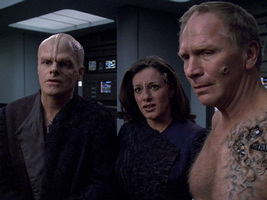
 "Survival Instinct"
"Survival Instinct"